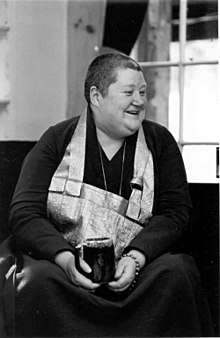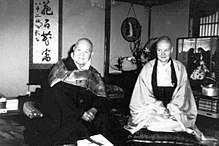Houn Jiyu-Kennett

| Hōun Jiyu-Kennett | |
|---|---|
| Religion | Buddhism |
| School | Sōtō Zen Buddhism |
| Education |
Durham University Trinity College of Music |
| Personal | |
| Born |
Peggy Teresa Nancy Kennett January 1, 1924 St Leonards-on-Sea, Sussex, United Kingdom |
| Died |
November 6, 1996 (aged 72) Mount Shasta, California, United States |
| Senior posting | |
| Based in | Shasta Abbey |
| Title | Rōshi |
| Predecessor | Keido Chisan Koho |
| Successor |
Daizui MacPhillamy former Head of the Order Haryo Young Head of the Order Eko Little Former Abbot of Shasta Abbey Meian Elbert Current Abbess of Shasta Abbey Daishin Morgan Abbot of Throssel Hole Abbey Gyokuko Carlson Kyogen Carlson James Ishmael Ford |
| Religious career | |
| Teacher |
Seck Kim Seng Suigan Yogo |
| Part of a series on |
| Zen Buddhism |
|---|
 |
|
Persons Chán in China
Zen in Japan Seon in Korea Zen in the USA Category: Zen Buddhists |
|
Awakening |
|
Practice |
|
Related schools |
| Part of a series on |
| Western Buddhism |
|---|
.jpeg) |
|
Main articles |
|
|
|
|
|
|
General Buddhism
|
Hōun Jiyu-Kennett (Japanese: 法雲慈友ケネット, January 1, 1924 – November 6, 1996), born Peggy Teresa Nancy Kennett, was a British roshi most famous for having been the first female to be sanctioned by the Sōtō School of Japan to teach in the West.
Biography
Early years
Hōun Jiyu-Kennett was born as Peggy Teresa Nancy Kennett in St Leonards-on-Sea, Sussex, England on January 1, 1924. As a young woman she found herself questioning gender roles in society and grew to become disillusioned with Christianity. She studied medieval music at Durham University and then received a scholarship to Trinity College of Music in London, England.[1] Though attracted to Buddhism, she felt during this period that she was called to serve the Church of England as a priest. However, church policies at the time did not allow women to be ordained, and this enhanced her previous disillusionment with Christianity.
Buddhist studies

She first became interested in Theravada Buddhism during this period of questioning and searching, joining the London Buddhist Vihara. In 1954 she joined the London Buddhist Society, where she continued her Buddhist studies and lectured. While there, she met the scholar D.T. Suzuki, and developed a strong interest in Rinzai Zen Buddhism. In 1960 when Keido Chisan Koho of Sojiji in Japan came to the society, she was asked to make the arrangements for his stay. Koho asked if she would consider becoming his student back in Japan. She accepted the offer, and two years passed before she arrived at Sojiji to study Soto Zen Buddhism under him.[1]
In January 1962, Kennett traveled to Malaysia to accept an award she had been honored with for setting a Buddhist hymn, "Welcome Joyous Wesak Day" by Sumangalo,[2] to music.[1] Before leaving for Japan, Kennett was ordained a novice nun by Venerable Seck Kim Seng (釋金星; Shì Jīnxīng)[1] in the Linji Chan school and given the Buddhist name Jiyu (慈友, Cíyou in Chinese, Jiyu in Japanese) meaning compassionate friend.
Jiyu-Kennett arrived in Japan in 1962, and trained at Sōjiji from 1962 to 1963, under Keidō Chisan Koho Zenji and one of his senior officers, Chisan Koho (Suigan Yogo), because Koho Zenji was often preoccupied with administrative affairs.
She received Dharma transmission from Keidō Chisan Koho Zenji on May 28, 1963, but also from Chisan Koho Roshi.[3]
Jiyu-Kennett's Zuise[4] ceremony was conducted in public in Japan, becoming an Oshō, i.e. "priest" or "teacher." Previously, women's ceremonies were held in private, but Koho had decided that the practice of holding private ceremonies for women and public ceremonies for men was wrong. According to Jiyu-Kennett's account,
I have never done a ceremony with more terror inside me than that one with twelve men down each side, each one with curtains drawn as if to say 'I'm not here.' Those were the witnesses. Try that sometime! That can be pretty scary—in a foreign country, in a language you're not one hundred percent sure of, with a lot of people who are hating your guts. And the reason Koho Zenji did it—and I've got it on tape—was for the benefit of women in his country.[5]
Abbess and start of teaching career
Following her Zuise ceremony, Jiyu-Kennett was installed as abbess of Unpukuji temple in Mie prefecture. By 1969 she received authorization to begin teaching Sōtō Zen in London, England. That year, she visited the United States on a lecture tour and decided to remain.[6] At this time Jiyu-Kennett was not in good health, as during her time in Japan she had experienced many illnesses.[7] In 1969 Jiyu-Kennett founded the Zen Mission Society in San Francisco, and in 1970 Shasta Abbey in Mount Shasta, California,[8] the first Soto Zen school in the United States to be established by a woman. In 1972, Jiyu-Kennett's British chapter of the Zen Mission Society established Throssel Hole Priory in Northumberland, England.[9][10] In 1978 Jiyu-Kennett changed the name of the Zen Mission Society to the Order of Buddhist Contemplatives.
Temporary resignation as abbess
In 1975 Jiyu-Kennett was stricken with illness yet again, and this time she became bedridden. In 1976, worn out and convinced death was near, she resigned from her position as abbess of Shasta Abbey and went into retreat in Oakland, California. Still rather ill, of unknown causes, she had her student Daizui MacPhillamy with her often to tend to her care. Following a kensho experience he had, she conferred Dharma transmission to him at her bedside in 1976.[7]
Visions
During this retreat, Jiyu-Kennett experienced a 'third kensho' which is documented in her book "How to Grow A Lotus Blossom or How a Zen Buddhist Prepares for Death", originally published in 1977 by Shasta Abbey Press. A second edition of this book, including later, subsequent visions, was published in 1993.
[3] Stephen Batchelor describes these episodes,
The visions lasted for 12 months, until 26 January 1977, the first twelve occurring in Oakland, the rest at Shasta, where she returned on 25 October. Each vision unfolded as a dream-like episode, charged with Western and Buddhist religious symbolism, superimposing itself on whatever she saw around her. She compared the series of visions to an elaborated contemporary version of the classical Zen images of the ten 'ox-herding' pictures. By the time the final vision faded, she was cured. She interpreted the experience as that of a 'third kensho.'"[7]
Around four months into her 'third kensho', Jiyu-Kennett regained her health and again assumed her position as Abbess of Shasta Abbey for the next 20 years until her death on November 6, 1996.
Teaching style
Jiyu-Kennett had a commanding presence about her, both intellectually as well as physically. Of a rather husky build, she had a tremendous laughter and was known to be gifted at storytelling.[5] To some, her demeanor appeared rather persistent at times, as author James Ishmael Ford writes,
My memories of Jiyu Kennett Roshi as a teacher are mixed. She followed in the authoritarian style of her Japanese inheritance. Interpersonally, she was remarkably invasive. Indeed, in my twenties, she pushed me into a marriage with another student that would cause great unhappiness for both of us. On the other hand, she had genuine insight into the boundless realm and also pushed me toward my own deepest experience of the great matter."[3]
According to the book The Encyclopedia of Women and Religion in North America,
Her adaptation of Zen for Westerners has been likened to Japanese Soto Zen with a flavor of the Church of England, for she believed that Zen in North America should adopt Western monastic dress and liturgical forms. For example, she set the traditional Buddhist liturgy to music based on Gregorian chants."[11]
Jiyu-Kennett was an advocate for equality between the sexes, as was Great Master Dogen.
Dharma heirs
- Haryo Young (Head of the Order of Buddhist Contemplatives)
- Meian Elbert (Abbess of Shasta Abbey)
- Daishin Morgan (Abbott of Throssel Hole Buddhist Abbey)
- Daizui MacPhillamy
Among many others...
Legacy
The Order of Buddhist Contemplatives, founded by Jiyu-Kennett, now has chapters in the United States, the Netherlands, Canada, the West Indies, the United Kingdom and Germany.
Bibliography
- Jiyu-Kennett; MacPhillamy, Daizui (2005). Roar of the Tigress: The Oral Teachings of Rev. Master Jiyu-Kennett, Western Woman and Zen Master. Shasta Abbey Press. ISBN 0-930066-24-3.
- Jiyu-Kennett (1999). Zen is Eternal Life. Tuttle Publishing. ISBN 0-930066-20-0.
- Nearman, Herbert; Jiyu-Kennett; MacPhillamy, Daizui (1998). Buddhist Writings on Meditation and Daily Practice: The Serene Reflection Meditation Tradition, Including the Complete Scripture of Brahma's Net. Shasta Abbey Press. ISBN 0-930066-18-9.
- Jiyu-Kennett (1996). Serene Reflection Meditation. Shasta abbey Press. ISBN 0-930066-16-2.
- Jiyu-Kennett (1993). How to Grow a Lotus Blossom, Or How a Zen Buddhist Prepares for Death, 2nd edition. Shasta Abbey Press. ISBN 0-930066-10-3.
- Keizan; Nearman, Hubert; Jiyu-Kennett (1993). The Denkōroku, Or, The Record of the Transmission of the Light. Shasta Abbey Press. ISBN 0-930066-13-8.
- Nearman, Hubert; Jiyu-Kennett; Sotoshu (1993). The Monastic Office. Shasta Abbey Press. ISBN 0-930066-14-6.
- Jiyu-Kennett (1987). The Liturgy of the Order of Buddhist Contemplatives for the Laity. Shasta Abbey Press. ISBN 0-930066-07-3.
- Jiyu-Kennett (1980). Zen Meditation. Shasta Abbey Press.
- Jiyu-Kennett; MacPhillamy, Daizui (1979). The Book of Life. Shasta Abbey Press. ISBN 0-930066-04-9.
- Jiyu-Kennett (1979). The Shasta Abbey Psalter. Shasta Abbey Press. OCLC 82217069.
- Jiyu-Kennett (1979). The Shasta Abbey Book of Ceremonies. Shasta Abbey Press. OCLC 13951501.
- Jiyu-Kennett (1978). The Wild, White Goose: The Diary of a Zen Trainee. Shasta Abbey Press. ISBN 0-930066-02-2.
- Jiyu-Kennett (1972). Selling Water by the River: A Manual of Zen Training. Pantheon Books. ISBN 0-394-46743-4.
- Jiyu-Kennett (1972). Zen Mission Society: Scriptures & Ceremonies. J. Kennett. OCLC 15989285.
See also
References
Sources
- Batchelor, Stephen (1994). The Awakening of the West: The Encounter of Buddhism and Western Culture. Parallax Press. ISBN 0-938077-69-4.
- Boucher, Sandy (1993). Turning the Wheel: American Women Creating the New Buddhism. Beacon Press. ISBN 0-8070-7305-9.
- Carroll, Bret E. (2000). The Routledge Historical Atlas of Religion in America. Routledge. ISBN 0-415-92131-7.
- Fowler, Merv (1999). Buddhism: Beliefs and Practices. Sussex Academic Press. ISBN 1-898723-66-4.
- Kennett, Jiyu (1999). Zen is Eternal Life. Tuttle Publishing. ISBN 0-930066-20-0.
- Kennett, Jiyu (1987). The Liturgy of the Order of Buddhist Contemplatives for the Laity. Shasta Abbey Press. ISBN 0-930066-07-3.
- Kay, David N. (2004). Tibetan and Zen Buddhism in Britain: Transplantation, Development and Adaptation. Routledge. ISBN 0-415-29765-6.
- Lowman, Catherine (1993). Women's Leadership in Marginal Religions: Explorations Outside the Mainstream. University of Illinois Press. ISBN 0-252-02025-1.
- Skinner Keller, Rosemary; Rosemary Radford Ruether; Marie Cantlon (2006). The Encyclopedia of Women and Religion in North America. Indiana University Press. ISBN 0-253-34685-1.
- Snelling, John (1991). The Buddhist Handbook: A Complete Guide to Buddhist Schools, Teaching, Practice and History. Inner Traditions. ISBN 0-89281-319-9.